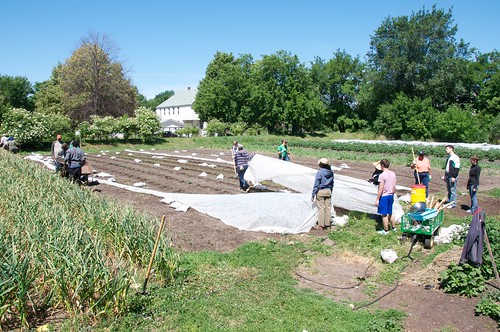|
by Lyn Lomasi, Write W.A.V.E. Media Staff As you are reading this, there are children in America who don't know if they will eat today. How is this possible when America has so many available resources? Are we really using what have to the fullest advantage? Urban gardens are known for reducing hunger. What if we took it a step further and required all schools to have them? Can school garden farms reduce childhood hunger?
Childhood Hunger in America According to FeedingAmerica.org, 16.7 million American children faced hunger issues in 2008. In a country as abundant as this, why should this be an issue? Rearranging priorities may help. What if schools were required to have garden farms that provided nutrition for the entire neighborhood? This would be a simple program to implement. In fact, there are already grants and other plans in place for those who wish to do so. Why Create School Garden Farms? School gardens can help teach kids about agriculture. Giving them a head start in important sustainability lessons may help increase the chance of their success later in life. Schools are often the center of their neighborhood. It's where many events and gatherings take place. The farming could be implemented into the curriculum. At harvest time for each plant, the kids can divide the crops evenly, according to how many people need them. There will likely be plenty for their families, as well as others in the neighborhood. If various crops are planted according to season, there should be plenty of food year-round. When school is not in session, the garden can still be maintained. This will help make up for the lack of nutrition many people suffer from. Can School Gardens Really Reduce Childhood Hunger in America? According to UrbanHarvest.org, community gardens help reduce hunger. Following that pattern, wouldn't it make sense that a school garden could help reduce hunger in children? If the food was distributed evenly to all neighborhood families by default, people may not be so hesitant to take it. Sometimes people are in need, but are embarrassed to admit they need help. Some may not have adequate transportation to get to that help. By making the community garden a part of the school's curriculum and regular routine, it's possible that childhood hunger could be reduced significantly. Taking away the sometimes grueling application experience and other measures may make this option more desirable for some families. With this type of plan, no one needs to feel left out and no one needs to be put on the spot or labeled. More on Hunger: Feeding America Hunger and Poverty Statistics Urban Harvest on Why Community Gardens are Valuable Texas Agriculture Commissioner Todd Staples on Urban Gardens *I originally published a version of this via Yahoo Contributor Network
0 Comments
by Michael Thompson, Contributing Writer
To feed the poor in Detroit, the Capuchin Soup Kitchen doesn't just look for cash and canned good donations.
The 2-acre Earthworks urban farm that surrounds the soup kitchen facility provides plenty of fresh fruits and vegetables.
Some of the 460-ton harvest goes on the plates of the soup kitchen's 100 daily patrons. Other portions of the produce are given to family's in need. Sales to support the project are made on site and at downtown's Eastern Market.
Earthworks expanded in 2001 and began working with the Wayne County Department of Heath, which oversees the federal Women Infant and Children (WIC) food program. One aspect of WIC is Project FRESH, which encourages parents to serve their children fresh fruits and vegetables rather than unhealthy fast food and snacks. In this respect, produce from the Earthworks farm is helping to combat child obesity.
Learn more about Earthworks and Capuchin Soup Kitchen:
http://www.cskdetroit.org/ http://www.cskdetroit.org/EWG/ |
Speak Up!
Archives
July 2018
Categories
All
|
- Brand Shamans
- Brand Healing
- Inner Healing
-
INTENT-SIVE NATURE
- Content & Brand Elevation
- Healing Jewelry & Talismans
- Bath, Beauty, & Self-Care
- Healing Sessions
- Rituals, Herbs, & Altar Supplies
- Gawwwdess Baby Boutique
- Soul Flame Gifts
- Yoga & Meditation
- Books & Media
- Education & Homeschool Resources
- Home, RV, & Decor
- Clothing
- Pets
- Custom Orders
- Monthly Subscription Boxes
- October Festivals
- Herbal Intent
- FLOW-Key Parenting
- About & Contact
- RV, Nature, & Travel Shamans
- Souls Within
- Life & Home
- Heart 'N Mind Homeschool
- The Homeschooling Mommy
- Books & Authors
- Speak Up!
- Pawsitive Pet Parenting
- Manifesterz
- Gifts In Minutes
- Brand Shamans
- Brand Healing
- Inner Healing
-
INTENT-SIVE NATURE
- Content & Brand Elevation
- Healing Jewelry & Talismans
- Bath, Beauty, & Self-Care
- Healing Sessions
- Rituals, Herbs, & Altar Supplies
- Gawwwdess Baby Boutique
- Soul Flame Gifts
- Yoga & Meditation
- Books & Media
- Education & Homeschool Resources
- Home, RV, & Decor
- Clothing
- Pets
- Custom Orders
- Monthly Subscription Boxes
- October Festivals
- Herbal Intent
- FLOW-Key Parenting
- About & Contact
- RV, Nature, & Travel Shamans
- Souls Within
- Life & Home
- Heart 'N Mind Homeschool
- The Homeschooling Mommy
- Books & Authors
- Speak Up!
- Pawsitive Pet Parenting
- Manifesterz
- Gifts In Minutes






 RSS Feed
RSS Feed




